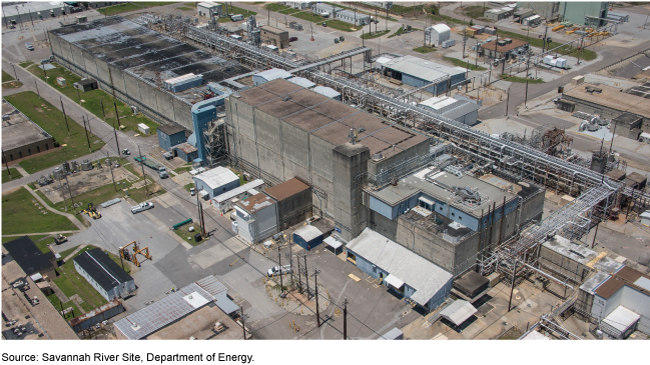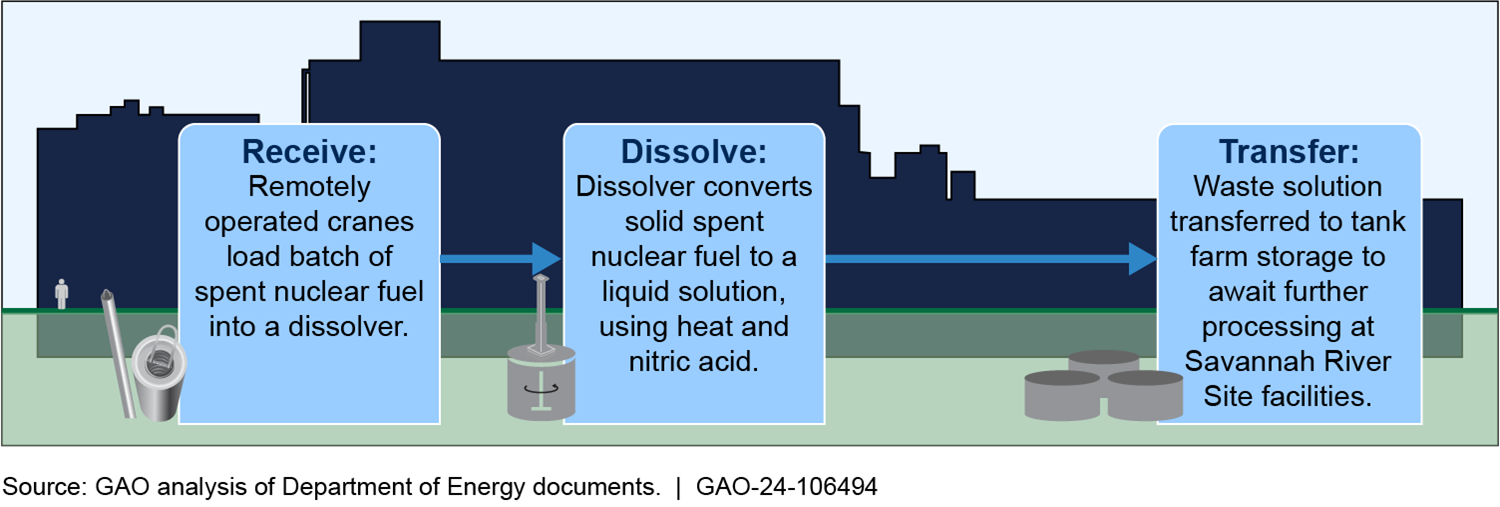Nuclear Materials: DOE Plans for Savannah River Site's H-Canyon Facility
Fast Facts
The Department of Energy uses the H-Canyon facility in South Carolina to help process certain nuclear materials for disposal—such as spent nuclear fuel that contains highly enriched uranium. Some of these materials have no other means of disposal, are unstable, and pose risks to people and the environment.
Several programs within DOE and one at another federal agency rely on this facility that may close in 2034. But DOE doesn't have written agreements with all of them, which would help everyone understand roles, responsibilities, and timeframes.
We recommended DOE have written agreements for all programs that rely on the H-Canyon facility.
H-Canyon Facility at Savannah River Site

Highlights
What GAO Found
The Department of Energy (DOE) uses Savannah River Site's H-Canyon facility primarily to process a significant amount of nuclear materials not readily disposable in their existing forms. DOE's Office of Environmental Management manages H-Canyon, and a contractor operates it.
H-Canyon processes spent nuclear fuel—used fuel removed from nuclear reactors—and other materials from DOE and other federal programs. The resulting waste solution enters Savannah River Site's liquid waste system for further processing and disposal or storage. As part of its environmental cleanup plans, the Office of Environmental Management plans to close parts of the site's liquid waste system in the late 2030s.
Streamlined Processing of Nuclear Materials in the Savannah River Site’s H-Canyon 
DOE has memorandums of agreement or similar written agreements to help facilitate collaboration between the Office of Environmental Management and some of the federal programs that rely on H-Canyon, such as DOE's Office of Science. However, it does not have agreements with DOE's Office of Nuclear Energy, the National Nuclear Security Administration, and the National Institute of Standards and Technology for ongoing mission needs. Documenting the Office of Environmental Management's agreements with all programs that rely on H-Canyon in written agreements would help ensure that all roles, responsibilities, and time frames are understood. It would also better align all components of H-Canyon's work and provide a solid basis on which to plan next steps for mid- and long-term operation of the facility. DOE has already begun these planning efforts.
Key nuclear and facility safety requirements for H-Canyon are intended to protect workers, the public, and the environment from consequences associated with an accident at the facility. The contractor operating H-Canyon implements safety requirements. The Office of Environmental Management assesses safety implementation through planned and unplanned safety assessments. The office engages with independent entities that also assess safety at H-Canyon.
Annual contractor costs to operate H-Canyon averaged just over $154 million, adjusted for inflation, from fiscal years 2013 through 2023. Factors affecting costs include the amount of nuclear material processed. The Office of Environmental Management officials and contractor representatives at the Savannah River Site said they plan to keep future costs relatively stable through fiscal year 2034. They expect decreased cost estimates during fiscal years 2035 to 2037 due to concluding H-Canyon's missions. DOE has two ongoing planning efforts for processing and managing spent nuclear fuel and other materials after H-Canyon's current missions end.
Why GAO Did This Study
Savannah River Site's H-Canyon is the sole chemical separations facility in the U.S. H-Canyon is integral to DOE's disposition of nuclear materials sourced from across the DOE complex that are unstable and pose risks to safety, health, and the environment. In April 2022, DOE announced plans to accelerate processing nuclear materials in H-Canyon to better align with some of the Office of Environmental Management's environmental cleanup plans for the Savannah River Site that are set to conclude in the late 2030s.
Senate Report 117-130 includes a provision for GAO to assess aspects of H-Canyon. This report provides information on H-Canyon's current missions, integration of plans to support these missions, key safety requirements, and operating costs.
GAO assessed documents and data related to the integration of plans for H-Canyon operations, as well as the safety and cost of H-Canyon. GAO visited the Savannah River Site to better understand H-Canyon's role in nuclear materials and spent fuel disposition. GAO interviewed federal officials—such as from DOE programs, the National Nuclear Security Administration, and the National Institute of Standards and Technology—and contractor representatives.
Recommendations
GAO is making three recommendations to DOE related to entering into written agreements with the Office of Nuclear Energy, the National Nuclear Security Administration, and the National Institute of Standards and Technology for the planned use of H-Canyon to process nuclear materials for ongoing mission needs. DOE concurred with the recommendations.
Recommendations for Executive Action
| Agency Affected | Recommendation | Status |
|---|---|---|
| Department of Energy | The Secretary of Energy should ensure that the Senior Advisor of EM and the Assistant Secretary of the Office of Nuclear Energy enter into a written agreement for the planned use of H-Canyon to process any future shipments of domestic research reactor fuel, including fuel from the University Fuel Services program. (Recommendation 1) |
DOE agreed with this recommendation. In its November 2023 response letter, DOE stated that EM and the Office of Nuclear Energy will develop a written agreement describing the collaborative process the two programs will use to plan shipments and receipts of domestic research reactor fuel. DOE estimated completing this action by December 2024.
|
| Department of Energy | The Secretary of Energy should ensure that the Senior Advisor of EM and the Administrator of NNSA enter into a written agreement for the planned use of H-Canyon to process any future shipments of foreign research reactor fuel not already included in an MOA or written agreement. (Recommendation 2) |
DOE agreed with this recommendation. In its November 2023 response letter, DOE stated that EM and NNSA will develop a written agreement describing the collaborative process the two programs will use to plan shipments and receipts of foreign research reactor fuel not already included in an MOA or written agreement. DOE estimated completing this action by December 2024.
|
| Department of Energy | The Secretary of Energy should direct the Senior Advisor of EM to work with the Director of NIST to enter into a written agreement for the planned use of H-Canyon to process any future shipments of domestic research reactor fuel from the NIST Center for Neutron Research program. (Recommendation 3) |
DOE agreed with this recommendation. In its November 2023 response letter, DOE stated that EM will work with NIST to develop a written agreement describing the collaborative process that will be used to plan shipments and receipts of domestic research reactor fuel from the NIST Center for Neutron Research program. DOE estimated completing this action by December 2024.
|
